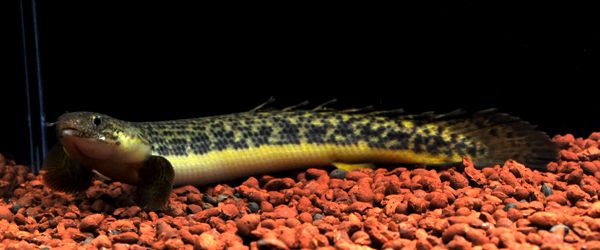The teugelsi bichir is a medium sized bichir that grows to 16 inches in length. It is found in the Cross River drainage basin in the Central African country of Cameroon. It is most commonly found in shady, slow moving rainforest streams with lush growths of overhanging marginal vegetation. Sexual dimorphism is unconfirmed, but is most likely similar to other bichirs in which the male has a much larger anal fin than the female.
The teugelsi bichir is an incredibly hardy, nocturnal species with poor eyesight that relies on its excellent sense of smell to locate food. This species, along with others of its genus, is one of the last surviving relatives of very ancient species. Fossils of earlier relatives have been found that date as far back as the Triassic Period, which occurred during the early development of dinosaurs over 200 million years ago.
Bichirs have several interesting adaptations. The swim bladder is divided into 2 parts, the right hand section is considerably larger than the left hand section. It functions as an accessory breathing organ and means the fish can survive out of water for quite some time, provided it is kept moist. Similar to the Ananbantoid species, bichirs may actually drown if denied access to atmospheric air. Young bichirs have external gills which are lost as the fish matures. This trait coupled with their nocturnal mode of hunting, in which they emerge from their daytime refuges to hunt invertebrates and small fish in shallow water, clearly exhibits the link these species form between fish and amphibians.
The teugelsi bichir is a member of the “upper-jawed” group of polypterids in which the upper jaw is longer than or equal in length to the lower jaw. This group also includes the Senegal, ornate, and armored bichirs.
The coloration and pattern exhibited by the teugelsi bichir is unique to the genus, consisting of a network pattern of black marks on the top half of the body, contrasting with the orange belly and jet black pectoral fins. It also has a more elongated and proportionately more slender body than other Polypterus species. This species was only discovered in 1988 and was described to science in 2004. This also sets the teugelsi bichir apart as all other known species of bichir were described to science prior to the year 1911.
The teugelsi bichir should be kept in an aquarium of 120 gallons or larger. Floor space is more important than tank depth. A sandy (CS7581) substrate with driftwood, tree roots, and smooth rocks arranged to form hiding places makes an ideal habitat for these large fish. Live or artificial plants are not essential but may be utilized if desired. A tight fitting lid is a must as these fish are excellent escape artists and may jump out of the aquarium.
Teugelsi bichirs prefer a temperature of 77°F to 82°F, a pH of 7.0 to 7.5, and a hardness 1 - 5° dH. Excellent water quality is a must.
The teugelsi bichir is not to be trusted with tank mates it can fit in its mouth but is relatively peaceful otherwise. Suitable tank mates include other Polypterus species, Synodontis, Datnoides, Knife Fish, larger Ctenopoma species, medium to large characins, large Rift lake cichlids and African Butterfly Fish.
The teugelsi bichir is carnivorous by nature and will not usually accept dried foods in the aquarium, though some specimens have been known to take high quality pelleted varieties (NL1008, OSI7346). The most suitable options are meaty live or frozen foods such as krill (SF7136), earthworms, mussel, and lance fish (silversides (ON1035)). Small specimens may be fed frozen blood worms (SF4792) and black worms.








